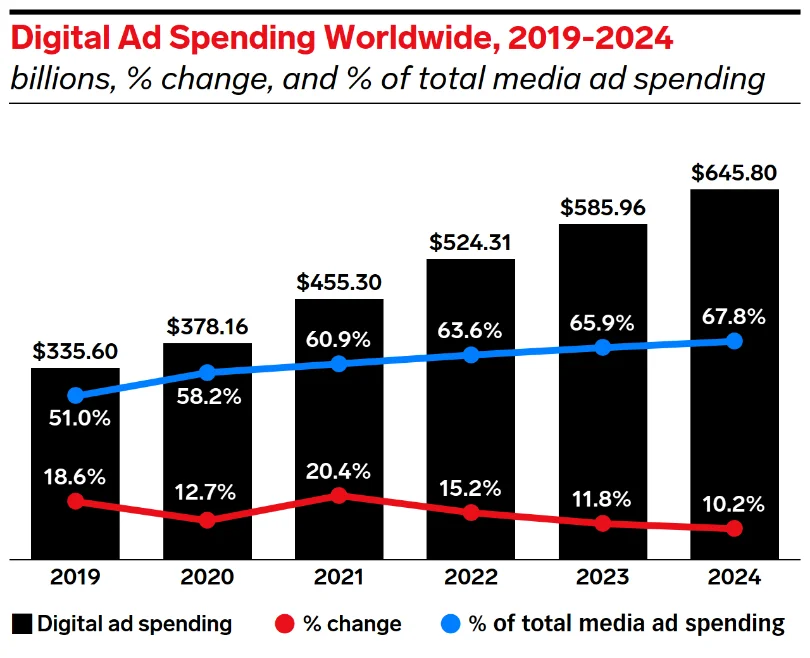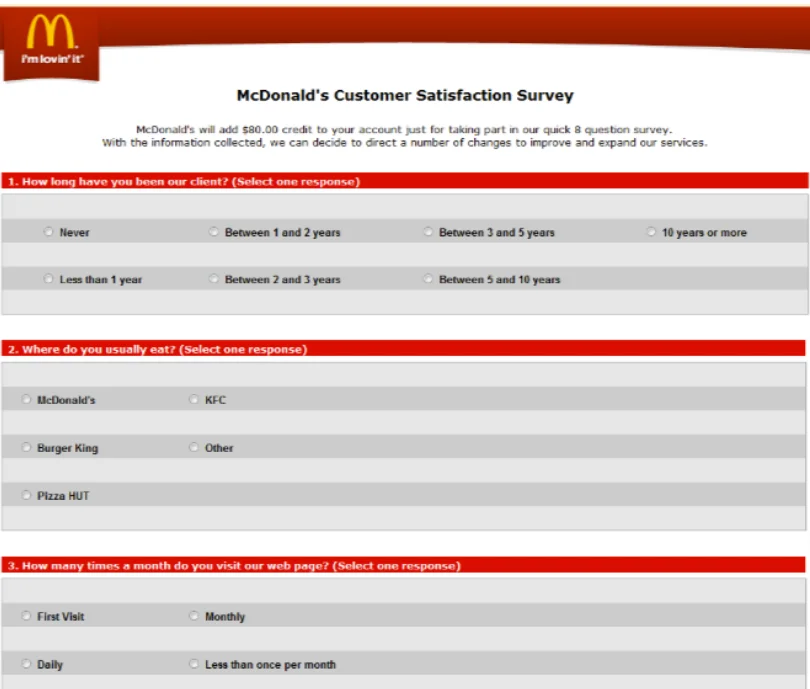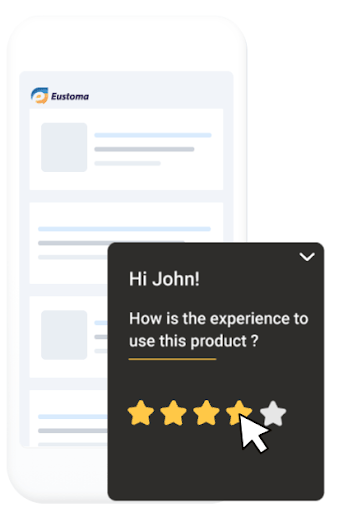
Shivani Dubey specializes in crafting engaging write-ups and exploring the intricacies of customer experience management. She covers vital topics such as customer feedback, voice of the customer (VoC), NPS, emerging UX and CX trends, and sentiment analysis.
Learn about Our Editorial Process Author & Editor at ProProfs Updated: 1 Sep, 2024
Ever wondered what your customers truly think about your brand? How much do they trust you? Where does their loyalty lie? Brand awareness survey questions can uncover these critical insights.
Let’s dive into a simple example. When you hear the word ‘burger,’ what pops into your mind first? It’s likely a brand, logo, or product flashing before you. This phenomenon is known as top-of-mind awareness or simply brand awareness.
Research shows that nearly 69% of customers are likelier to buy from a brand they already know.
This makes understanding and building brand awareness a top priority for any business.
Ready to unlock these powerful insights? Let’s get started!
A brand awareness survey is designed for measuring how aware your customers are about your brand. In other words, it helps you better understand how your customers perceive and think of your brand.
It’s a great way to find out how much your target audience knows about your brand’s existence. Apart from that, brand awareness surveys can also help you identify:
But a survey is only as effective as the questions it contains. Specific questions can help you gather reliable data, while an unoptimized brand awareness survey can make things worse for your business.
Here are some effective brand awareness survey question examples divided into different sections to make them easier for you to understand. You can build as many questions as you like based on different aspects of brand awareness.







Brand awareness surveys are vital because they reveal how well people recognize your brand. This feedback helps you understand if your marketing efforts are working and allows you to adjust your strategy for better brand recognition and ultimately, more business.
Apart from that, brand awareness surveys can also help you achieve the following:
A lot of companies just focus on sales because people often buy their products without focusing on the brand. It’s just the product that matters.
It’s good for generating revenue in the short term, but when you look at the big picture, you’d want to be the go-to choice for people whenever they need a product that you specialize in.
Companies mostly do this by pumping loads of money into ads and other marketing campaigns to improve their brand recall value.
By conducting surveys on brand awareness, you can gauge if your target audience is aware of your brand. If you’re already on top of their mind, you can do away with aggressive marketing to stay on top of search results because your audience will choose you nonetheless.
In fact, digital ad spending worldwide is forecasted to reach $645.8 billion in 2024 from $335.60 billion in 2019.
But that’s not all because some of the biggest companies like MindBody, Salesforce, and Oracle spend almost 20% of their revenue on marketing.

Once you know how many people know and consider buying from your brand, you can allocate appropriate resources to improve brand awareness instead of going too aggressive with your marketing.

These brand awareness surveys help McDonald’s identify problem areas and push their brand forward by:
McDonald’s makes itself stick in the customers’ minds while significantly reducing the cost of advertising.
Today, McDonald’s operates in over 120 countries and has around 38,000 restaurants globally.
Successful marketing isn’t just about targeting the ideal or direct user persona; it’s also about targeting the potential prospects that affect the decision-making of your target customers.
It’s crucial to analyze and distinguish between your users and customers to launch successful marketing campaigns.
The ideal users of your product might not be the ones making the purchase decision.
For example, your target user may be a child who uses your online education platform, but the parents are the ones calling the shots for purchase.
So, an ideal marketing strategy will target both the users (children who’ll study on the platform) and the customers (parents who’ll buy the subscription).
The same goes for targeting different user demographics based on gender, income, profession, etc.
Here’s a real brand example of bringing home our point.
To their surprise, a brand survey by Old Spice found that the actual customers responsible for 60% of purchases for their body wash were women.
They launched a marketing campaign with an advertisement starring Isaiah Mustafa, a popular figure, claiming that although other men may not look like him, women can make their partners smell like him.

In a study, people were blindfolded and made to try Pepsi and Coke. The majority of the participants chose Pepsi. But, when they were asked to choose a drink without the blindfold, they chose Coke. This win was solely owed to the brand image of Coke.
So, what’s the takeaway? Customers purchase the brand first and the product/features second.

Inman, a leading real estate news platform, wanted to increase awareness about the Real Estate Connect conference in San Francisco.
The brand used feedback software Qualaroo’s survey Nudge™ to boost engagement and awareness and leveraged branching logic to uncover popular topics among visitors.
The survey found that 76% of the visitors weren’t aware of the event. So, with the right content, they could pitch in the event and boost awareness.
With that, we now have a pretty clear idea about how some of the most popular brands leveraged brand awareness surveys. Now, let’s look at some brand awareness survey question examples.
Which question do you think speaks to you in a better way?
We’re no mind readers, but pretty sure it’s the second one.
This is what powerful personalization does. By simply playing with the words, you can make your brand awareness questionnaires much more appealing to your audience and create an image of your brand that they won’t forget.

But that’s not all because personalizing your touchpoints makes customers more aware of your brand, but even more so, it helps you improve your survey response rates and build a more customer-centric brand.
According to McKinsey 71% of consumers expect companies to deliver personalized interactions.
You can start by adding pleasantries and warmth in your email subject lines, notifications, survey messaging, and survey questions to make them more personal and collect feedback from your customers.
Also, same as before- you can use the built-in customization options of your online feedback tool to redesign your questionnaire on brand awareness and overhaul the entire look and feel of your brand surveys.
But that’s not all because personalizing your touchpoints makes customers more aware of your brand, but even more so, it helps you improve your survey response rates and build a more customer-centric brand.
According to McKinsey 71% of consumers expect companies to deliver personalized interactions.
You can start by adding pleasantries and warmth in your email subject lines, notifications, survey messaging, and survey questions to make them more personal and collect feedback from your customers.
Also, same as before- you can use the built-in customization options of your online feedback tool to redesign your questionnaire on brand awareness and overhaul the entire look and feel of your brand surveys.
Then follow up with a survey on brand awareness after a few months to see how things are holding up now that your campaigns are over.
Conduct these brand awareness surveys over a period of time to test which strategies work and make changes if needed.
With targeted surveys, you can gauge how your target audience reacts to your brand and perceive it via brand associations. You can target qualities like “innovative,” “trustworthy,” and “inspiring” to see which ones your audience associates your brand with.
The key here is to always stay on top of your feedback collection process and always check how perceptions and awareness of your target audience change over time.
Following up on the feedback and closing the feedback loop is the best way to let your customers know they are being listened to.
If your customers know their feedback is valued, it does not go in vain; it creates a positive brand perception and improves brand loyalty.
Customers also want to provide feedback about their experiences with the brand.
But if they find out that their feedback holds no value, they won’t return. You must first understand your target audience’s sentiment to close the feedback look.
But how are customer emotions and brand awareness related in the first place?
Well, studies show that customers rely on emotions rather than information when choosing a brand for themselves. This is where an emotional response towards your brand can make or break it.
For this, you can start by simply segregating your data based on your NPS scores to see how your audience feels about your brand. Here, the customers who score high on NPS can be made your brand ambassadors to promote your brand. On the other hand, you can get in touch with customers who score low on NPS to resolve their problems and leave a positive brand image.
The challenge comes when you have a large audience base because that makes it impossible for you to analyze all responses manually.
That’s where you can get help from the automatically generated reports from your feedback tool that do all the segregation for you.
You can use your feedback tool’s built-in sentiment analysis engine if you want to go even deeper into the analysis process. It’ll automatically analyze descriptive feedback and highlight your customer’s emotions towards your brand through detailed reports.
Gathering feedback will help you make necessary changes and create better products. However, going deeper and understanding the emotional awareness of your target audience will unlock a world of possibilities.
Open-ended questions (the likes of which we discussed above) can be paired with the sentiment analysis engine to understand how your customers feel using emotional scores based on the feedback.
Conducting brand awareness surveys regularly is crucial for tracking changes and trends over time. By consistently gathering data, you can monitor the effectiveness of your marketing efforts, identify shifts in consumer perceptions, and adjust your strategies accordingly.
A recommended approach is to conduct these surveys quarterly or biannually, allowing you to capture seasonal variations and stay responsive to market dynamics.
Regular surveys also help in benchmarking your brand’s performance, providing a clear picture of your growth and areas needing improvement.
Increasing response rates for brand awareness surveys can be challenging, but offering incentives can make a significant difference. Rewards such as discounts, gift cards, or entry into a prize draw can motivate participants to complete your survey.
It’s important to ensure that the incentives are appealing and relevant to your target audience. Additionally, clearly communicate the value of their feedback and how it will contribute to improving their experience with your brand. By showing appreciation for their time and effort, you can boost participation and gather more comprehensive data.
Encouraging honest feedback is essential for the accuracy and reliability of your brand awareness surveys.
Ensuring respondents’ anonymity can help achieve this. When participants know their responses are confidential, they are more likely to provide candid and truthful answers. This can lead to more accurate insights into their perceptions and experiences with your brand.
Implementing measures such as anonymous survey links and secure data handling practices can reassure respondents that their privacy is protected. By fostering a safe and anonymous environment, you can collect genuine feedback that truly reflects your brand’s standing in the market.
To get the most accurate and actionable insights, it’s essential to target the right audience for your brand awareness survey. Here’s a breakdown of who you should consider:
Measuring brand awareness effectively involves using a combination of qualitative and quantitative questions to capture different dimensions of brand recognition and perception.
Here are some key methods:
Remember, while products and customer preferences may change over time, a positive brand experience ensures customers choose your business over others. To achieve this, your brand must be memorable and instantly recognizable.
Brand awareness questionnaires are the perfect starting point for understanding your brand’s image. They provide insights into what people think of your brand and what they associate it with.
With these insights, you can design impactful marketing campaigns to build brand credibility, improve brand recall, and establish lasting trust with your customers. Ready to take your brand to the next level? Start with the right questions and watch your brand grow!
FREE. All Features. FOREVER!
Try our Forever FREE account with all premium features!